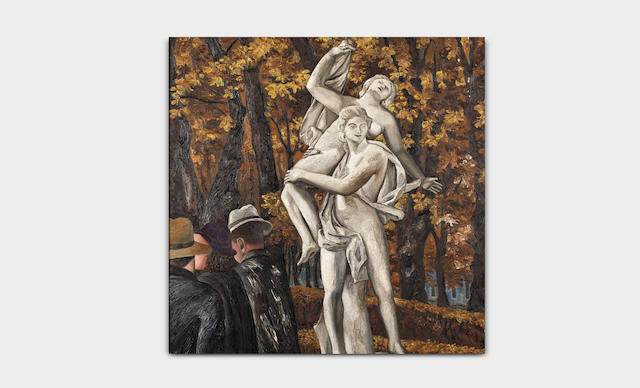Garden statues/Sculpture: An important life size lead figure of Hygieia by Bromsgrove Guild and modelled by Charles Bonnet early 20th century 196cm high. The Bromsgrove Guild of Applied Arts was established in 1894 by Walter Gilbert who took over a foundry in Bromsgrove, Worcestershire. It was first involved with decorative ironwork, but the business soon expanded into a great many other fields. By 1900 Gilbert had gone into partnership with a Mr McCandlish and had taken over further premises in the town which housed bronze and lead foundries, as well as wood and stone carving studios. By 1908 they had established an outlet in London, and as a result of their most famous commission, the iron and bronze gates outside Buckingham Palace, they were issued with a Royal Warrant appointing them metal workers to Edward VII (an honour repeated two years later under George V). Unlike the majority of other contemporary English manufacturers of garden ornaments most of the Guild’s figurative subjects were modelled in the popular styles of the day. In 1921 the Guild became a limited company, but by this date some of the members had left to start companies of their own. However, the Guild continued to produce a variety of garden ornaments for many years finally closing in 1966. The modeller of this statue, Charles Bonnet, despite his English sounding name was from Barcelona. Much of his work was of animals and birds and many of his statues were displayed in the show garden at the back of the Bromsgrove works in Station Road. Most of the Bromsgrove products were produced in quantity, and were available to purchase from the various catalogues produced by the Guild. This rare figure does not appear to have been illustrated in any of Bromsgrove Guild’s literature and the only other known example of this figure was commissioned for the garden of Chequers, which was originally the Buckinghamshire mansion belonging to Lord Lee, who presented the house to the nation in 1917 as a country residence for the use of future Prime Ministers. It still stands on the lawn in front of the main entrance to the house. Hygieia was a goddess in Greek mythology and was the daughter and chief attendant to Asklepios, the god of medicine. The cult of Hygieia started in Athens in the 600s BC, in connection with the cult of Athene, goddess of wisdom and purity. Statues of Athene and Hygieia stood at the entrance to the Acropolis temple in Athens. In classical sculpture she was often shown holding or feeding a large snake, (the symbol of Asklepion medicine). Literature: The Bromsgrove Guild - an Illustrated History, edited by Quintin Watt, published by the Bromsgrove Society 1999, page 63.
Garden statues/Sculpture: An important life size lead figure of Hygieia by Bromsgrove Guild and modelled by Charles Bonnet early 20th century 196cm high. The Bromsgrove Guild of Applied Arts was established in 1894 by Walter Gilbert who took over a foundry in Bromsgrove, Worcestershire. It was first involved with decorative ironwork, but the business soon expanded into a great many other fields. By 1900 Gilbert had gone into partnership with a Mr McCandlish and had taken over further premises in the town which housed bronze and lead foundries, as well as wood and stone carving studios. By 1908 they had established an outlet in London, and as a result of their most famous commission, the iron and bronze gates outside Buckingham Palace, they were issued with a Royal Warrant appointing them metal workers to Edward VII (an honour repeated two years later under George V). Unlike the majority of other contemporary English manufacturers of garden ornaments most of the Guild’s figurative subjects were modelled in the popular styles of the day. In 1921 the Guild became a limited company, but by this date some of the members had left to start companies of their own. However, the Guild continued to produce a variety of garden ornaments for many years finally closing in 1966. The modeller of this statue, Charles Bonnet, despite his English sounding name was from Barcelona. Much of his work was of animals and birds and many of his statues were displayed in the show garden at the back of the Bromsgrove works in Station Road. Most of the Bromsgrove products were produced in quantity, and were available to purchase from the various catalogues produced by the Guild. This rare figure does not appear to have been illustrated in any of Bromsgrove Guild’s literature and the only other known example of this figure was commissioned for the garden of Chequers, which was originally the Buckinghamshire mansion belonging to Lord Lee, who presented the house to the nation in 1917 as a country residence for the use of future Prime Ministers. It still stands on the lawn in front of the main entrance to the house. Hygieia was a goddess in Greek mythology and was the daughter and chief attendant to Asklepios, the god of medicine. The cult of Hygieia started in Athens in the 600s BC, in connection with the cult of Athene, goddess of wisdom and purity. Statues of Athene and Hygieia stood at the entrance to the Acropolis temple in Athens. In classical sculpture she was often shown holding or feeding a large snake, (the symbol of Asklepion medicine). Literature: The Bromsgrove Guild - an Illustrated History, edited by Quintin Watt, published by the Bromsgrove Society 1999, page 63.















Testen Sie LotSearch und seine Premium-Features 7 Tage - ohne Kosten!
Lassen Sie sich automatisch über neue Objekte in kommenden Auktionen benachrichtigen.
Suchauftrag anlegen